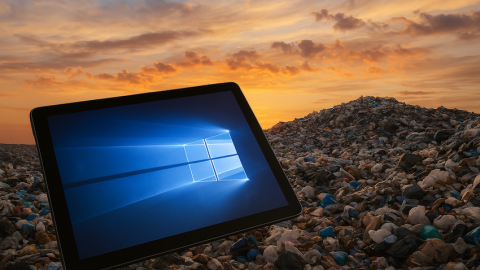Microsoft's decision to end support for Windows 10 will leave hundreds of millions of devices unable to meet the requirements for upgrading to Windows 11. Experts in Georgia Tech's College of Computing warn this policy will heavily contribute to the e-waste crisis and expose users to cybersecurity threats from unpatched vulnerabilities.
When Microsoft announced it was ending support for Windows 10 last week, about 40 percent of all Windows users faced limited options.
While some of those users can upgrade to Windows 11, hundreds of millions of devices don’t meet the technical requirements.
Those users might be wondering what else they can do besides throwing away their current device and buying a new one or risking running outdated software on it.
The tech conglomerate faced backlash from environmental and cybersecurity experts after informing Windows users that it would cease providing updates for Windows 10.
These experts have warned that rendering hundreds of millions of devices practically useless will worsen the ever-growing problem with electronic waste (e-waste) and leave users who can't upgrade vulnerable to cybersecurity threats.
Researchers from Georgia Tech’s School of Interactive Computing (SIC) and School of Cybersecurity and Privacy (SCP) echo those concerns.
Forcing users to replace their devices means that up to 240 million old devices, according to one analysis, will inevitably end up in landfills.
“The problem of e-waste raises the question of why and how these technologies become obsolete,” said Cindy Lin, a Stephen Fleming Early Career Assistant Professor in SIC.
Lin studies data structures and environmental governance in Southeast Asia and the U.S.
“Scholarship in human-computer interaction (HCI) on repair reveals that many of these technologies suffer from planned obsolescence,” she said. “This means that companies have designed products with a short lifespan, increasing consumption and waste simultaneously.”
When e-waste is dumped in landfills, the organic materials within devices decompose, producing methane, a potent greenhouse gas. And with every discarded device comes the need to produce new ones. The raw materials of these devices are mined, refined, and processed, consuming enormous amounts of energy through the burning of fossil fuels.
The Problem With Hackers
Though Microsoft said it will continue to provide Windows 10 security updates for one year, users are still being pressured to upgrade. By this time next year, if users still haven’t upgraded to Windows 11, they can expect to become easy targets for cyber criminals.
For example, users could receive phishing emails claiming to be from Microsoft about security updates from hackers pretending to be Microsoft.
“The cybersecurity implications are very serious because new vulnerabilities of Windows 10 will go unpatched for a large part of the user base of this system,” said Mustaque Ahamad, Regents’ Entrepreneur Professor and interim chair of SCP.
“These users will become targets of hackers and cyber criminals who will be able to exploit these vulnerabilities. This will make these machines more prone to attacks such as ransomware and data exfiltration.”
What Can Users Do?
Buying a new device typically costs around $300 at the low end, while some gaming computers can exceed $2,500.
Josiah Hester, an associate professor in the School of IC who researches computing and sustainability, said users who want to avoid discarding their devices can install Linux Mint, a free universal operating system.
“I would hope that instead of discarding, people might see this as an opportunity to go into a more open ecosystem like Linux Mint, which was designed for Windows users,” Hester said.
“So much perfectly good hardware is obsolesced by force, when users are more than willing to give it a second life, either through ending support on the software side, subscription services that require certain versions of an OS, or even building the hardware or low-level functions that reduce the autonomy of device owners.”
Linux Mint is open source and offers its own suite of software products, including a word processor. It also has a built-in security system. It requires 2GB of RAM, 20GB of disk space, and 1024x768 resolution to operate.
On a systemic level, Lin and Hester said people can support organizations that advocate for right to repair and legislation that protects consumers from planned obsolescence.
“HCI studies of informal economies of improvisation and repair have demonstrated that technologies have a longer lifecycle if we have access to expertise on how to repair them without facing penalties such as copyright violations,” Lin said.
“The ongoing right-to-repair movement in the US shows promise in making technology repairable and, in turn, more sustainable.”

